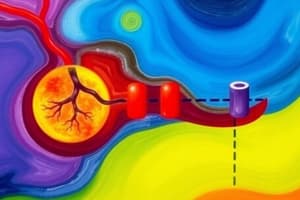Podcast
Questions and Answers
What is the function of glycolysis?
What is the function of glycolysis?
To break down glucose into two molecules of pyruvate. Additionally, 2 NADH form and 4 ATP molecules are made.
What happens to the molecules formed during glycolysis when oxygen is available?
What happens to the molecules formed during glycolysis when oxygen is available?
When oxygen is available, the pyruvate and NADH are used for cellular respiration in the mitochondria.
What is meant by a 'net gain of two ATP molecules' from glycolysis?
What is meant by a 'net gain of two ATP molecules' from glycolysis?
Glycolysis makes 4 ATP molecules, but 2 ATP molecules are used to first split the glucose molecule, resulting in a net gain of 2 ATP molecules.
What is the function of the Krebs cycle?
What is the function of the Krebs cycle?
What is the 1st step of the Krebs cycle?
What is the 1st step of the Krebs cycle?
What is the 2nd step of the Krebs cycle?
What is the 2nd step of the Krebs cycle?
What is the 3rd step of the Krebs cycle?
What is the 3rd step of the Krebs cycle?
What is the 4th step of the Krebs cycle?
What is the 4th step of the Krebs cycle?
What is the 5th step of the Krebs cycle?
What is the 5th step of the Krebs cycle?
What is the 6th step of the Krebs cycle?
What is the 6th step of the Krebs cycle?
Where is the electron transport chain in cellular respiration located?
Where is the electron transport chain in cellular respiration located?
What is the function of the electron transport chain?
What is the function of the electron transport chain?
What is the 1st step of the electron transport chain?
What is the 1st step of the electron transport chain?
What is the 2nd step of the electron transport chain?
What is the 2nd step of the electron transport chain?
What is the 3rd step of the electron transport chain?
What is the 3rd step of the electron transport chain?
What is the 4th step of the electron transport chain?
What is the 4th step of the electron transport chain?
Why is oxygen needed for cellular respiration?
Why is oxygen needed for cellular respiration?
Flashcards are hidden until you start studying
Study Notes
Glycolysis
- Glycolysis breaks down glucose into two pyruvate molecules, generating 2 NADH and a gross production of 4 ATP.
- In the presence of oxygen, pyruvate and NADH enter cellular respiration pathways in mitochondria.
- A net gain of 2 ATP from glycolysis results from producing 4 ATP but using 2 ATP to initiate glucose splitting.
Krebs Cycle
- The Krebs cycle starts by breaking down pyruvate into a 2-carbon molecule and releasing carbon dioxide, producing NADH.
- Coenzyme A attaches to the 2-carbon molecule that enters the Krebs cycle.
- Citric acid is formed by combining the 2-carbon molecule with a 4-carbon molecule.
- The citric acid is then broken down into a 5-carbon molecule, producing NADH and releasing carbon dioxide.
- The breakdown of the 5-carbon molecule yields a 4-carbon molecule, another NADH, and ATP, with more carbon dioxide released.
- The cycle finishes by rearranging the 4-carbon molecule, releasing high-energy electrons and creating NADH and FADH2 while retaining the 4-carbon backbone.
Electron Transport Chain
- Located in and across the inner mitochondrial membrane, the electron transport chain extracts energy from NADH and FADH2.
- High-energy electrons are removed from NADH and FADH2 by proteins within the inner membrane.
- The energy from electrons pumps hydrogen ions across the membrane, creating a chemiosmotic gradient.
- ATP production occurs as hydrogen ions flow back through ATP synthase, generating approximately three ATP for each pair of electrons.
- Oxygen serves as the final electron acceptor, combining with electrons and hydrogen ions to form water, a waste product of cellular respiration.
Role of Oxygen
- Essential for cellular respiration, oxygen facilitates the acceptance of electrons and hydrogen ions, leading to the production of carbon dioxide and water as waste products.
Studying That Suits You
Use AI to generate personalized quizzes and flashcards to suit your learning preferences.




